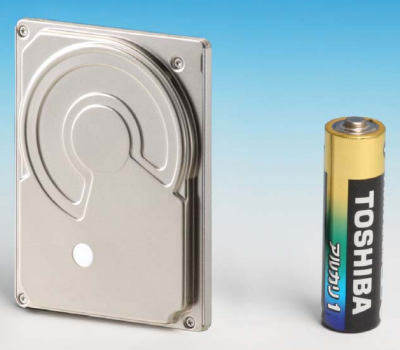Toshiba recently announced its new 240GB 1.8-inch hard disk drive, the MK2431GAH. Developed for consumer electronics and PC devices, this dual-platter drive has an areal density of 344 gigabits per square inch, the highest in the industry. The MK2431GAH also spins at 4,200 RPM and features a 100MB/s parallel ATA interface.

Toshiba Corporation, the pioneer in small form factor hard disk drives (HDDs), today announced the world's first dual-platter 240GB1) HDD (MK2431GAH). The new drive delivers the highest capacity1) and areal density in the 1.8-inch drive category for integration into portable media players, camcorders and mobile PCs. Toshiba also announced new 120GB (MK1231GAL) and 80GB (MK8031GAL) capacity offerings, rounding out the most complete line of high-capacity 4,200 RPM 1.8-inch HDDs for consumer electronics (CE) and mobile PC system manufacturers.
Toshiba's 240GB MK2431GAH and 120GB MK1231GAL achieve an areal density of 344 gigabits per square inch (531.9Mbit/mm2), the industry's highest areal density1) in the 1.8-inch form factor, using perpendicular magnetic recording (PMR) technology, which Toshiba introduced and commercialized in 2005. Toshiba's technology leadership in PMR has enabled the company to consistently deliver leading-edge capacities in the 1.8-inch form factor to support growing demand for miniaturization without sacrificing capacity for digital video, photo, audio and computing applications.
The new 1.8-inch HDD series uses a new mechanical and firmware design for enhanced durability, making the 80GB and 120GB single-platter HDDs well suited for slim-line mobile gadgets and PC applications. The new dual-platter 240GB MK2431GAH product is especially suitable for high-end digital video camcorders as well as light-weight mobile PC applications which require high capacity and high shock resistance to protect the users' valuable digital assets.
Toshiba's 120GB drive is now in production with the 240GB and 8GB models entering production at the end of September. If you'd like to read more, Toshiba's entire press release can be found here.

